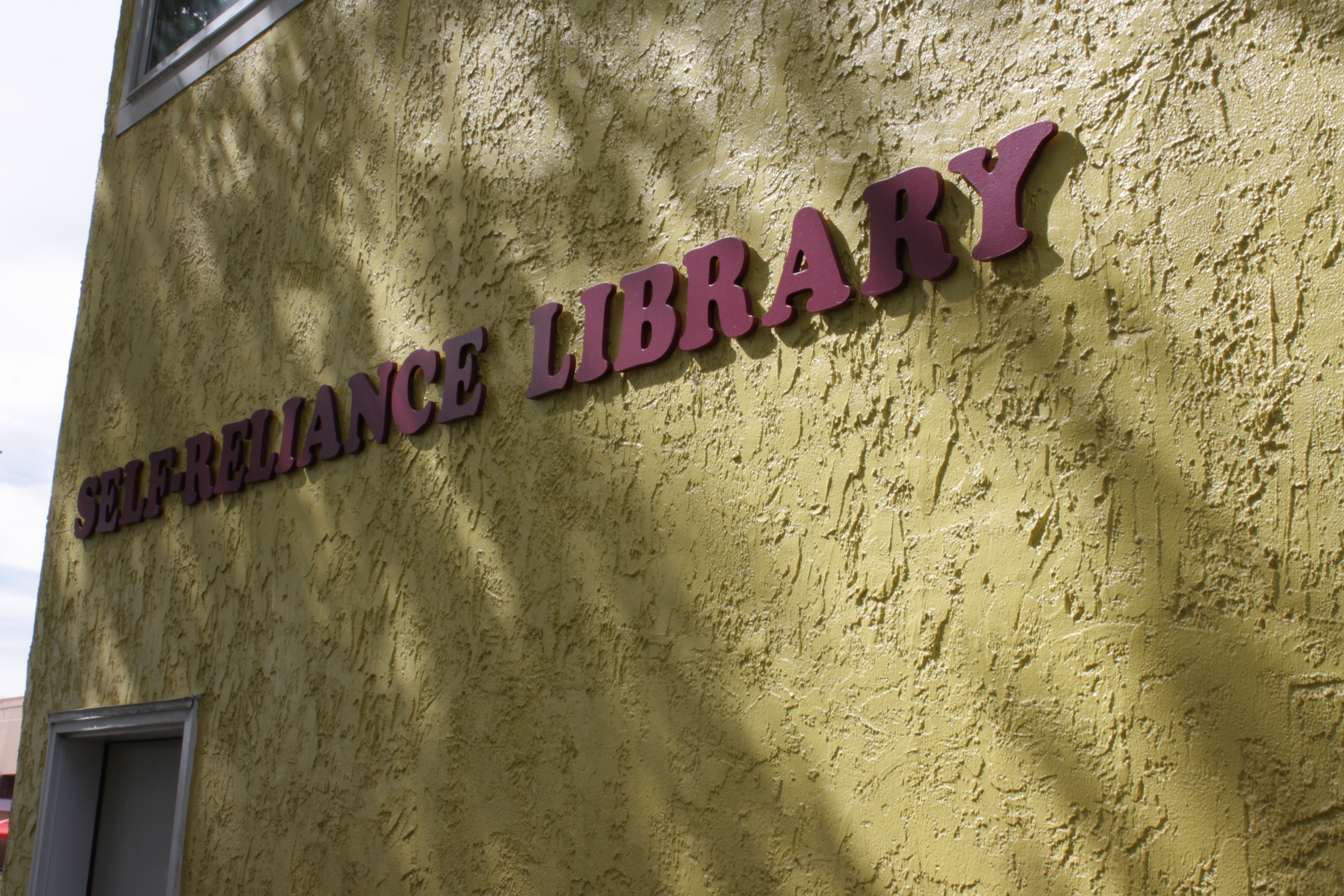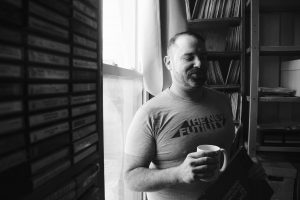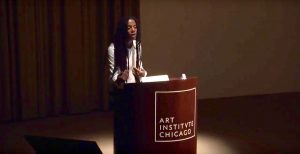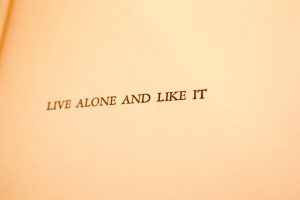In Chicago, as in many cities, a few degrees of separation can make a huge difference. Ridgeland Avenue, an Oak Park thoroughfare, and Austin Blvd, an entry-way into the Austin neighborhood, are divided by Lake Street, which is lined with shops, Pete’s Fresh Market, and the yellowest building, I would estimate, in a ten-mile radius. I walk towards Compound Yellow, an independent, experimental arts space, and feel like an invited intruder. The mere brightness of the building forces you to engage with it, but as you draw closer, the tenderness of the flags waving above the structure and the suspended cloth circles hanging from the trees indicate a sense of careful living.
The three buildings that comprise the compound have been united since 2016, the most noticeable one declaring itself as the Self-Reliance School & Self-Reliance Library, a collaboration between Compound Yellow and Chicago arts publisher Temporary Services.
The Self-Reliance Library is a reading and creating library, an installation consisting of over 80 books, as well as furniture and banners that take influence from ideas found in the library. The books are a mixture of old books and reference materials, new titles, and titles published by Half-Letter Press, an imprint of Temporary Services. The books are displayed in an exhibition style and there are several tables in which you can sit down with a pile of the books to explore. The bench style of the chairs makes it easy to look at the titles with others and share insight. The banners that hang on the walls are made out of embroidered plastic bags and each one displays a different quote from some of the books in the collection.
Connected to it is the Self-Reliance School, a studio and workshop space in which the organizers of Compound Yellow come together with community members, other artists and cultural producers to share, learn, teach, build and make stuff together. The space is teeming with book-making materials, zines, flyers, even costumes if you find yourself in the mood. It is open to all and they normally meet every other Friday evening to share potlucks, demonstrations, host talks, or just hang out. Often these activities are connected to material available in the library, but not always.
I sit in the front yard of the compound, waiting to meet with a few of its members to discuss the Self-Reliance School and the Self-Reliance Library. As I wait, I notice the remnants of the previous day sprinkled in the yard: someone’s down jacket, a business card tucked between mulch and a pile of rocks that have yet to be meticulously arranged by a child. There is a sign installed at the edge of the front yard before it meets the sidewalk, it reads “What Do You Need to Know? / ¿Qué Se Necesita Saber?” and has a box for people to slip their answers into. Two people approach the box and then shuffle through the bushes to greet me: educator Alisa Reith and artist Matthew Nicholas are the creators of the flags atop the Self-Reliance School and are collaborators at Compound Yellow.
We are then joined by fellow artist and collaborator Dylan Cale Jones, followed by Laura Shaeffer and Lora Lode, the co-founders of the space. We all sit on the second floor of the school and carefully study the pieces created from the previous day’s workshop called Many Possible Futures, which explored time traveling and generative thinking for artists, parents, educators, and kids.

(Left to right) Laura Shaeffer, Matthew Nicholas, and Alisa Reith observe work presented on a table from workshop participants in the Self-Reliance School. Photo by Hannah Siegfried.
Natasha Mijares: So what is the origin story of Compound Yellow and how did the vision of the school and library come together?
Lora Lode: We’ve all known each other in varying capacities. I’ve known Matt for quite a while. We’ve created stuff in spaces where it was open to participation. We’ve crossed paths many times that way. I’ve known Dylan for a while because we work at the same institution, of which we will not speak its name at the moment. Just kidding, it’s The School of the Art Institute of Chicago. But it’s been great working with Dylan at Compound Yellow, where he curates the film series because he has great ideas and responses. Laura and I go way back. Laura’s done so many projects, one of which is the South Side Hub (SHoP). From afar, I admired and visited a few times and I was working with Mess Hall at the same time, which was an experimental cultural center in Rogers Park. They both ended at a similar time so we both talked a lot about how these spaces of participation and experimentation were so great and were kind of going away and then just fortuitously, we all sort of ran into each other last year and started talking about doing something together. The space presented itself to Laura and her family, and then she invited us all to collaborate.
Laura Shaeffer: My dream with the South Side Hub and The Op Shop was always to be one of a collective, where everyone felt the same kind of empowerment to be able to make suggestions, curate something, and do something with the space, which was difficult at times. I think it just takes time to build up these relationships and to know what you really want and then to focus on that and make it happen. Group work is always a work in progress, but I feel grateful that now we kind of found each other.
NM: You’ve described yourselves as a cooperative, and a big way that cooperatives work is through set rules, a structure, or lack thereof. Is there a kind of code or way that you designed the space in mind to have people move in and out or with a certain kind of intention?
Alisa Reith: I was not involved in the starting of Compound Yellow at all, I became acquainted this past summer, but my interpretation of the structure is that it’s very fluid and dynamic, and that to me encourages a lot of collaboration that wouldn’t otherwise happen. Not to say that there is no structure, there’s a lot behind the scenes that I am not aware of, but I think the fact that I have never considered myself an artist before and that I am included at all, speaks to the way that the space is co-created. It enables anyone to participate in any way that they can.
Dylan Cale Jones: There is a culture of pitching in. When I would do film screenings here, people would offer to stay and help clean up and people would bring food. I think a big part of it is that it’s Laura’s home and it presents itself as that, not like how a gallery does. If this place is more like a home, then a gallery is more like a store. A store is tended to by the people who sell the things in it so you’re not expected to pitch in, you’re expected to go there and consume or take in what’s happening there and leave, whereas coming here, there’s all this stuff that is expounded upon beyond a home, which is a lot. It requires a lot of work and labor to take care of this space and maybe more than one person or one family can handle. I think it’s recognized by people who come here who understand that context. I don’t think it’s necessarily a feeling of obligation, it’s just part of the experience of coming here.
LS: I’ve been thinking about the whole development of structure. Last night at the talk about Ken Isaacs, people were talking about living in proximity to each other and unfortunately, none of us really live close to each other so we really have to conscientiously stay together in some way. Ideally, I suppose, there would be two families living on this property so that the work is shared. But I think what we’ve all kind of committed to with this is that we weren’t going to necessarily follow the structures and models that are out there but we were going to learn from the past, what worked or what was exciting from other projects, not just our own projects but projects that exist in the world in order to develop a new structure for us. I can feel that things are taking shape, we’re starting to understand what’s exciting about the possibilities in this location. I’m looking forward to the future.
NM: I’d like to shift into programming and how you’ve gone about that in terms of working with the artists of the collective itself, the impact of the community, and other people’s voices.
Matthew Nicholas: I think the idea of the Self-Reliance School has been a focused idea to direct what will happen here by just doing it and not curating themes to exhibitions. I think the idea of having generative programming is really interesting. I think the project that we’ve been working on is how to program the space without even being here as a way to work around this idea of proximity to the physical space. How is this space activated all the time? How do we create a silent declaration of activity? How do you deal with messaging? It’s divisive and you have no control over that, regardless of what the statement is. Statements will always be divisive.

A selection of books on display inside of the Self-Reliance Library. Photo by Hannah Siegfried.
LS: The six months of the Self-Reliance Library was basically programmed by Temporary Services. They had six or seven speakers that were referring to part of the library, either a book that had been produced with Half-Letter Press or something they were working on, or a book release. That seemed like a clear way of programming. I feel like the school is now kind of taking over that programming by these three-month periods of time where each participant in the school is taking the idea that they may activate the entire compound in different ways but we would also help each other. So now we’re kind of breaking up the year in three month periods and the programming will be relevant to each artist/maker that are taking residence.
NM: We’ve been talking about programming and I’m kind of interested in the talk-backs or intentions that have been set after you’ve done a number of them. There are themes of self-reliance of community, so what are other big topics that you are all discussing together?
LL: I think in our guts, Laura and I knew, for example, in a space where there isn’t additional participatory action or a workshop environment generated, it feels more static, in a sense. There are objects in a space and while they are really fantastic and interesting, somehow there is something missing. Like yesterday, there was a texture to each activity. We were in this space and we were learning together. The person who was sharing this was so sincerely interested in what they were talking about and it wasn’t delivered in a typical lecture format.
I think that some institutional decisions and devices, not that they’re wrong or bad, they just don’t hit it right on in a way that makes you really want to sink your teeth into something. So even while Susan Snodgrass was talking and knew so much about Ken Isaacs, and clearly was the person speaking in the room, there was always the invitation to interject, to talk together.
The shift into the workshop also generates and pushes us into a variety of sensibilities in terms of ourselves and our awareness, it causes our consciousness to be prompted and to shift thinking. We like that it was an experiment and it was comfortable for the person to say “I am nervous about this experiment” and for us to say that “hey, we love that” combined with the convivial atmosphere of kids running around and the barbeque, it was just really great.
DCJ: Just kind of pigging off of that idea. Piggy backing. Pig off [the group giggles] I’m gonna pig off that idea.
LS: Be my troph!
DCJ: Gladly. Where was I? When I come here, I often end up talking to people who are not just visual artists but may identify as educators or activists or writers. That feels really rewarding and I think there’s lots of different ways of talking about being interdisciplinary or transdisciplinary. I think a lot of people in the art world consider that as jumping between different media, like being a ceramicist and a painter and combining ceramics and painting. Something different happens when a visual artist and an educator collaborate than when someone just works within different media. I also really like this idea of a bunch of different voices coming together and I think that is part of Temporary Services’ mission statement as well, not valuing art as being a separate thing in the world from everything else.
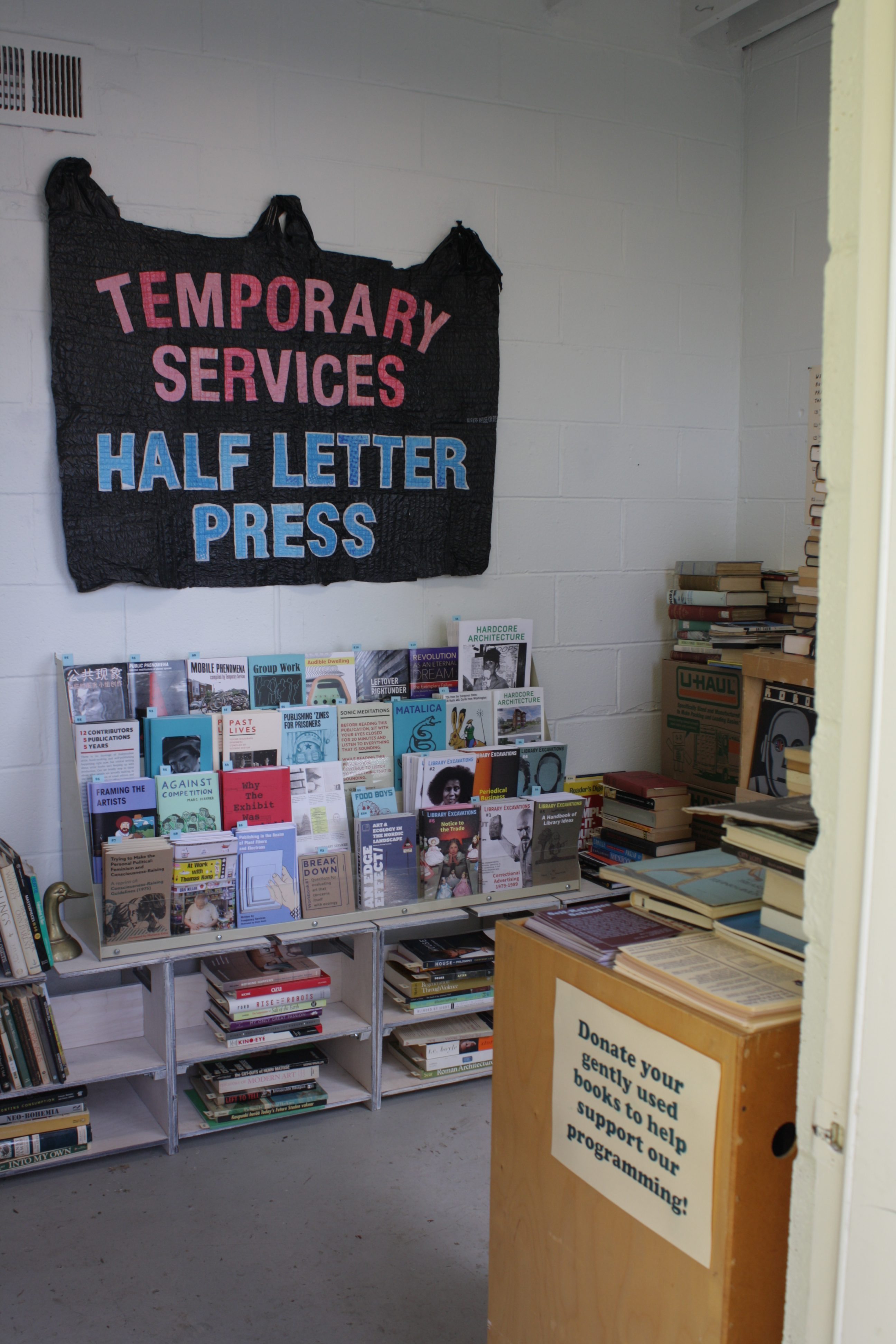
The bookshop at Compound Yellow houses books that are donated by the community and are for sale, as opposed to the books inside of the Self-Reliance School, which are for surveying. Photo by Hannah Siegfried.
NM: I want to talk about the library as a structure for social practice and how that’s been a very generative tool that many artists have used in different spaces throughout the world. So what was the decision to create a library in particular? There are many ways to showcase work, why would it be that way?
MN: I think what’s interesting about the library is it’s about value systems inherently like all libraries are. The Self-Reliance Library isn’t a critique on the traditional library but is questioning value systems. There’s a system of values within it and then there’s the bookshop, which is a whole other area of value systems where there are books for sale, or people can contribute, and then there’s the whole concept of free exchange.
The people that come in here and create projects make themselves vulnerable from an ethical position. To me, that’s the biggest thing, it can be hard to find art spaces to do that in. Someone coming in and facilitating a discussion is clearly making themselves vulnerable in a very ethical kind of way, cause they feel like they’re testing themselves, that’s what this space is doing. When you’re just constantly thinking about different value systems and knowledge-sharing, it’s like currency, but things don’t always equal anything. The work that someone does doesn’t always equal something that you get from it, in the way that the programming is working, you have to make that happen, I think that’s creating a new value system. What happens when you just make it?
LS: When we first started talking about inviting Marc Fischer & Brett Bloom of The Self-Reliance Library, we talked a lot about what self-reliance was and what it could be in our current culture. It’s interesting because it’s been here for six months and I don’t know how many times I’ve thought about what that means and, personally, how many times I’ve come across skills that I don’t have and have to recognize that I have to learn this in order to be a part of the kind of culture and community that I want around me.
LL: Someone said early on to me “oh self-reliance, do you mean like preppers?” and I was like “oh yikes! We certainly do not mean like preppers.” Or maybe we do mean preppers, but just that that question came up made us ask “what is self-reliance?” There is the idea of self-reliance as a skilling up, so to speak, but it’s also not self self. It is outside of consumer culture. It’s outside of relying on someone else to solve it for you, it’s outside of buying it at Ikea. So we thought, after this, we have to have The School of Interconnectedness cause that’s what we are really aiming for.
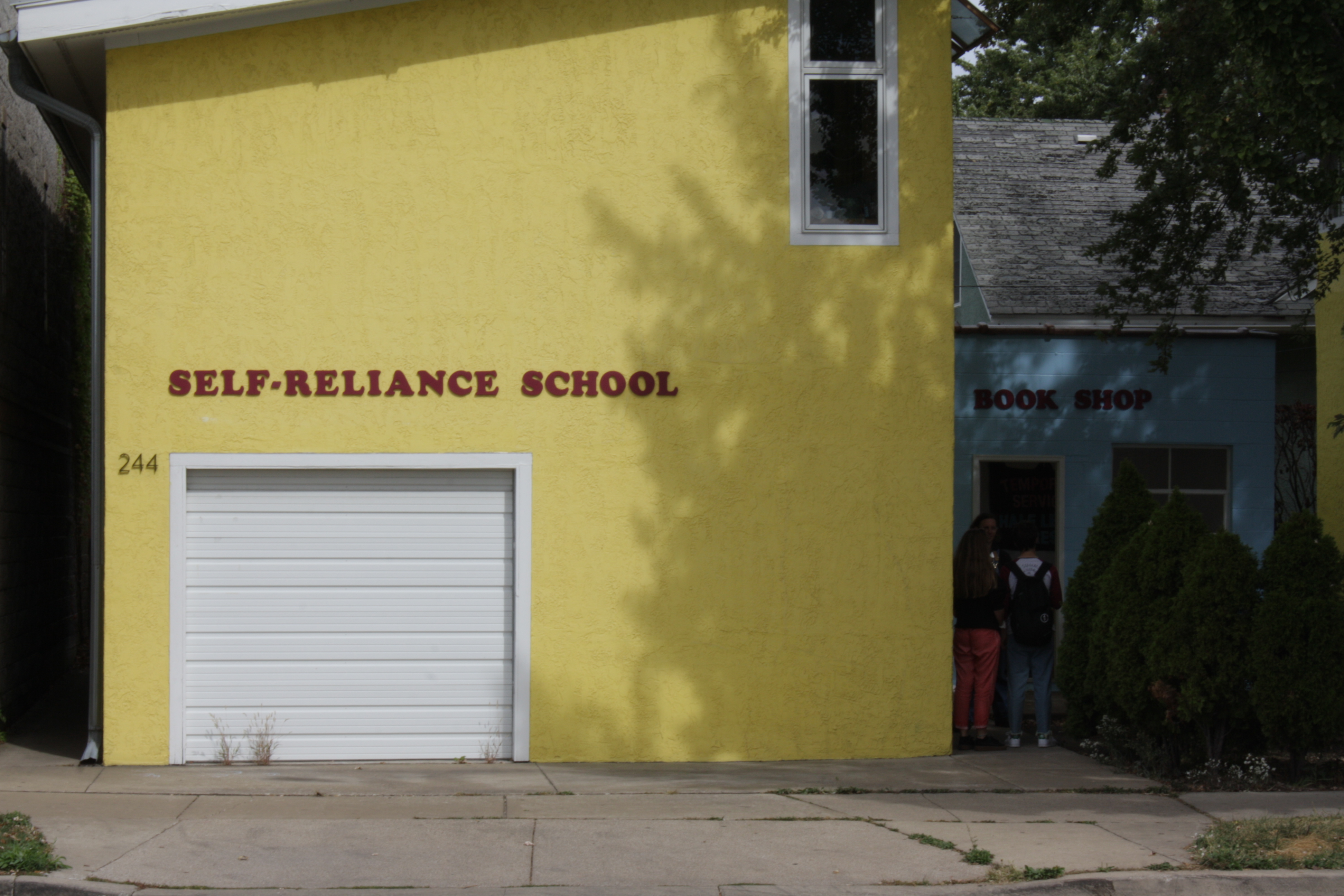
A view of the Self-Reliance School and Book Shop from across the street. Photo by Hannah Siegfried.
AR: It seems clear to me that self-reliance is self-defined. For some people it’s skilling up, but for me, I’ve internalized it more as how do I need to learn? I feel like, speaking back to how Matt mentioned vulnerability, in order to learn, you have to make yourself vulnerable and to learn, you have to struggle with multiple viewpoints and this is a space where that happens.
DCJ: I want to touch on what Laura was saying about preppers and this kind of form of self-reliance because there’s a way that self-reliance can be determined as rejecting being interconnected. This would be the extreme of self-reliance, which comes from fear, preppers are all about fear. There’s a fatalistic attitude towards that mode of cultural production, of collecting things for the end of the world and also so that you can get ready to fight people when shit goes down. Whereas the forms of self-reliance that are being explored in the Self-Reliance School and the Self-Reliance Library are ways of trying to stay afloat and recognizing that there are a lot of different crises in the world that need to be dealt with but doesn’t accept them in a way that’s fatalistic, but in a way that recognizes that fear and tries to generate solutions to avoid those crises or at least acknowledge them.
MN: I can’t stop thinking about the preppers now. I’ve had lots of discussions about the apocalypse and there’s always this idea in American culture about the end coming. There’s something attractive about it. It’s like “we get to be the heroes now,” it’s a big escapism thing that is anti-humanitarian. I always feel like we are actually living through the apocalypse and this is what it looks like and this is what it feels like, there’s nothing interesting or exciting about it. So I think it’s understanding that there are so many crises happening right now, that have been happening slowly, what’s exciting is how we choose to not separate ourselves from the moment.
NM: So now that the Self-Reliance Library is coming to a close, what is next for Compound Yellow?
LL: Spencer Hutchinson has a performance on October 28th. Starting on November 4th, Carlos Matallana will be doing some workshops around paper folding and it’s called “Democracy TBD.” In the spring, Melissa Potter wants to start the first feminist seed bank and Lucy Flowers will have a papermaking garden.
DCJ: I will be organizing Public Space Camp in the spring which is gonna be a series of workshops with different Chicago artists who deal with public space as material in their work. This features Hannah Barco, Aaron Walker, Hui-Min Tsen, myself, and includes a pop-up Read/Write Library and exhibition.
LS: We were invited to a block party the other day to talk about our project so Ally, Matt and I went and one of the main questions we were asked, from a writer, Susan Messer, was “what is then, your elevator speech?” which she was uncomfortable asking. Ally said something like “we take the stairs” and I think Matt chimed in and said “let’s walk.” Susan said she always hated the elevator speech cause she’s always been interested in the complexity of something so she wrote me a nice email afterwards, that ended in “I always take the stairs.”
Featured Image: An up-close, angled shot of the exterior of the Self-Reliance Library. Photos by Hannah Siegfried.
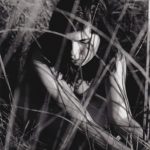 Natasha Mijares is an artist, writer, curator, and teacher. She received her MFA in Writing from The School of the Art Institute of Chicago. She has been published in Container, Calamity, Vinyl Poetry, Bear Review, and has work forthcoming from Hypertext Magazine.
Natasha Mijares is an artist, writer, curator, and teacher. She received her MFA in Writing from The School of the Art Institute of Chicago. She has been published in Container, Calamity, Vinyl Poetry, Bear Review, and has work forthcoming from Hypertext Magazine.
